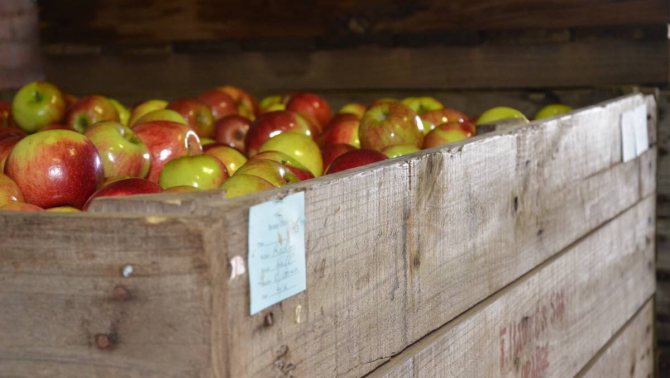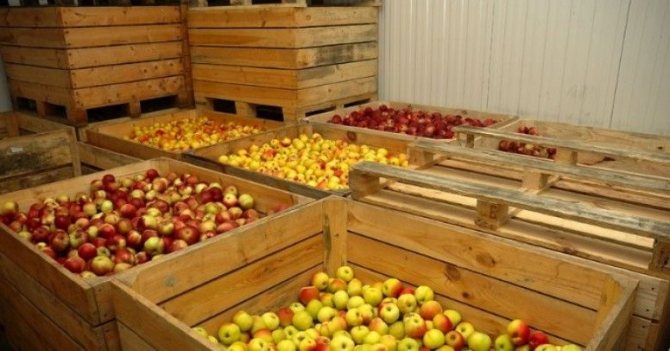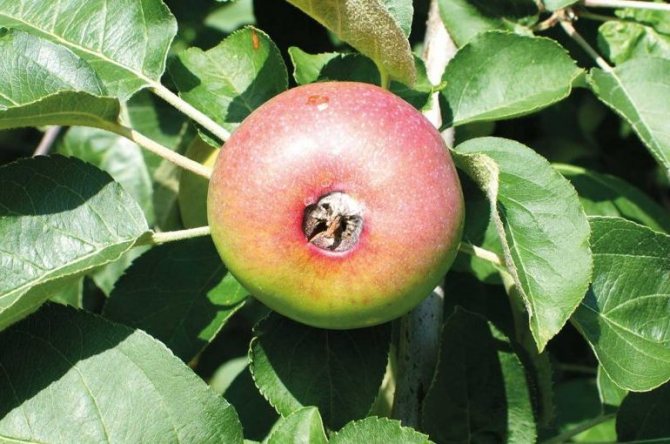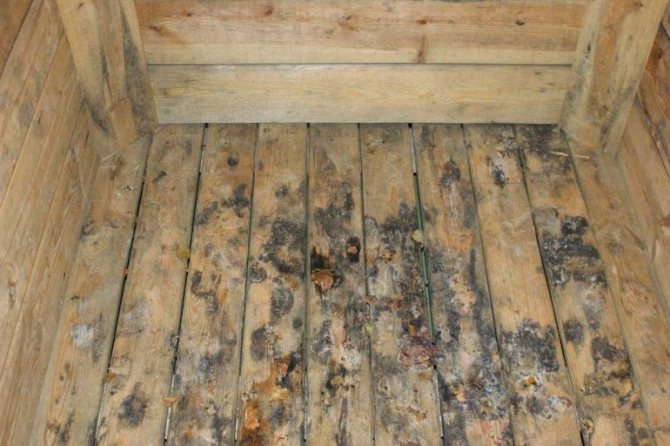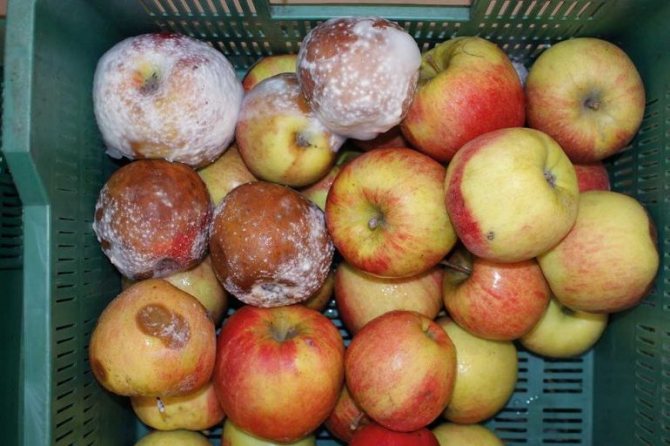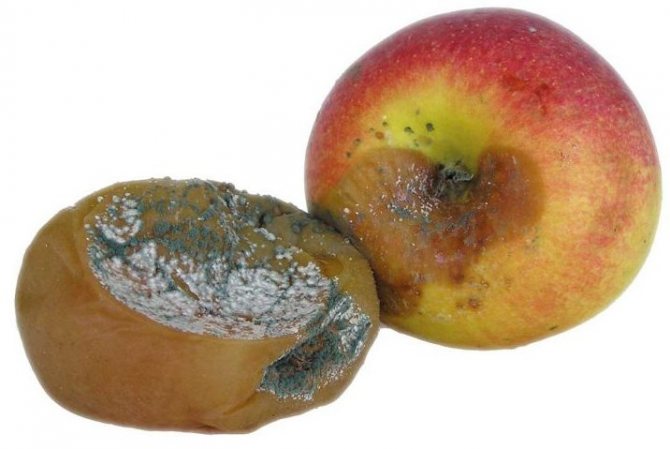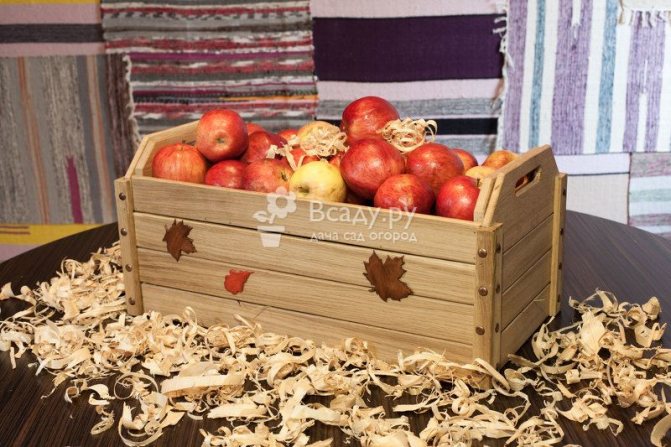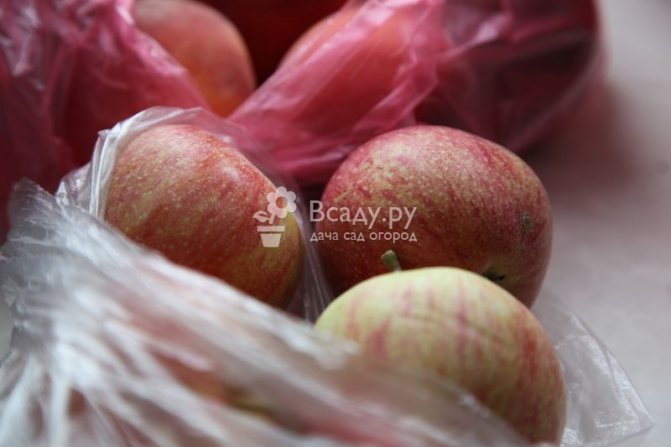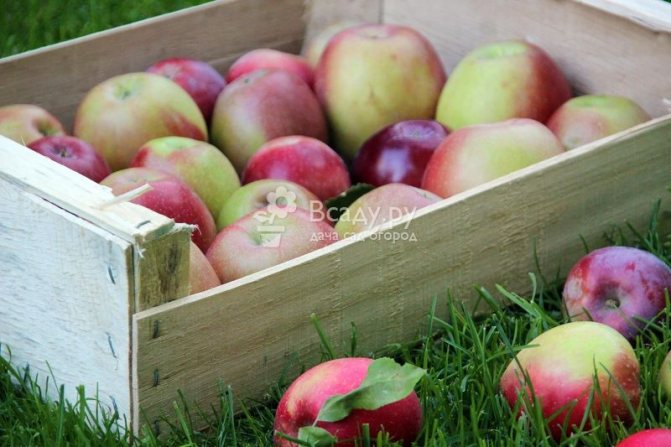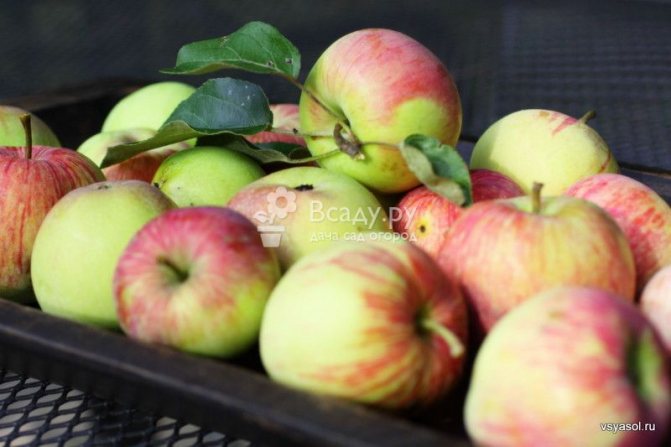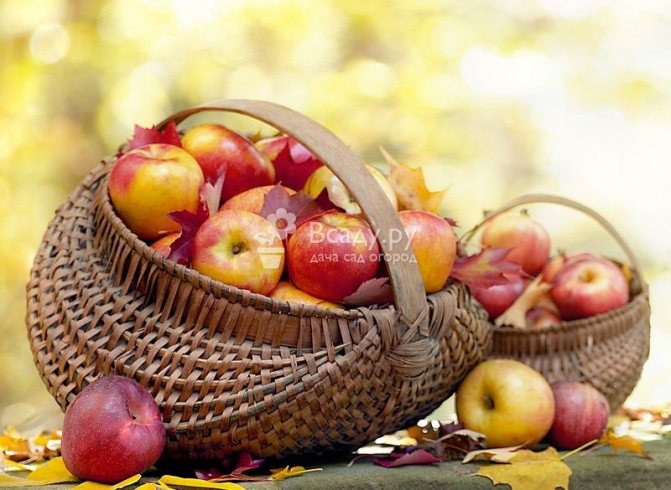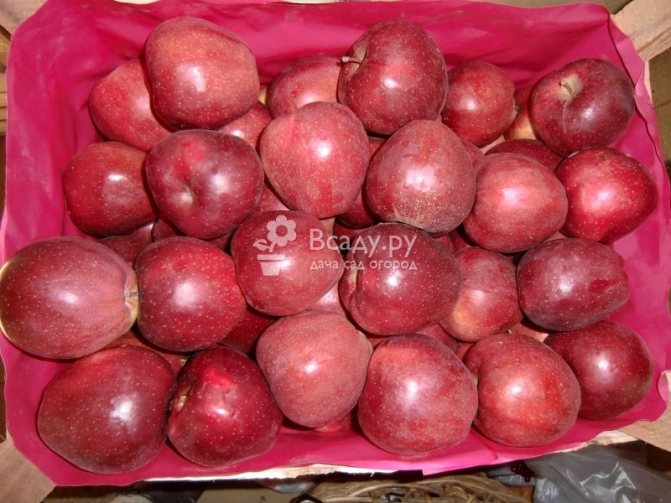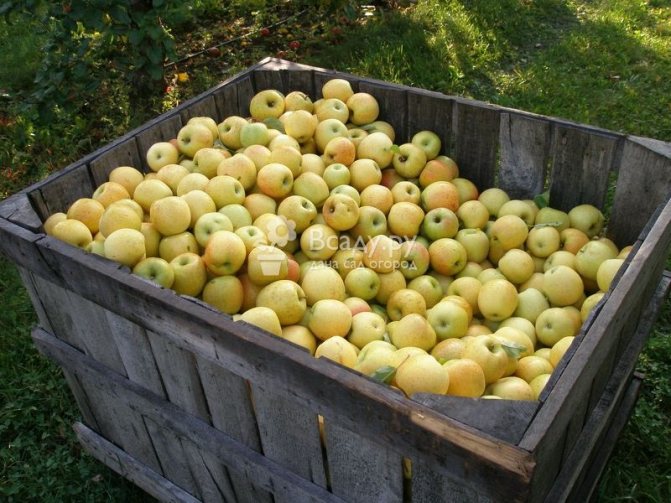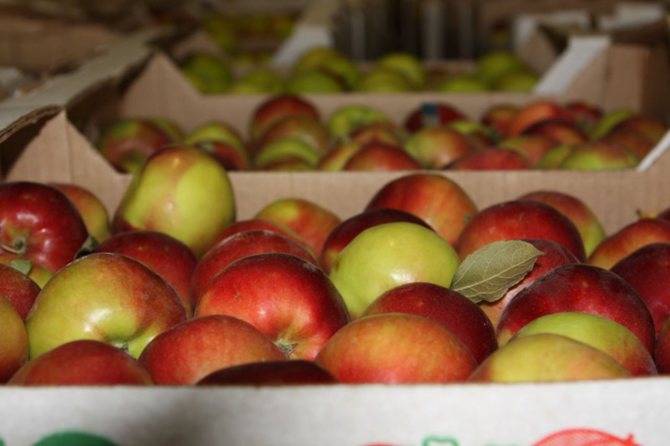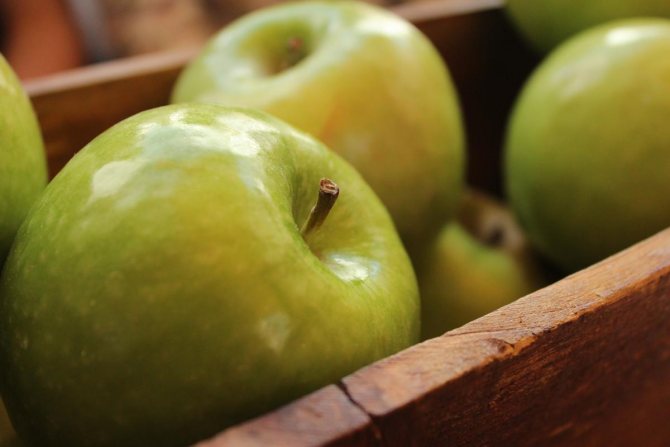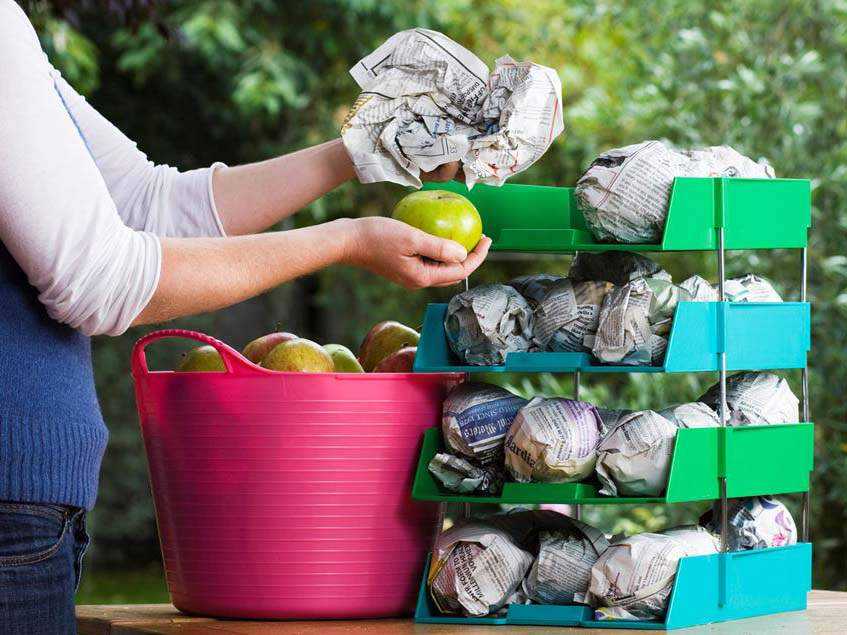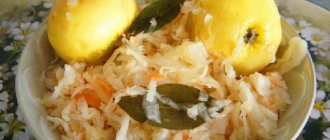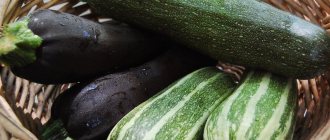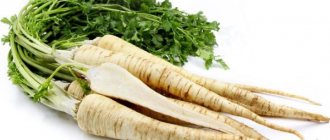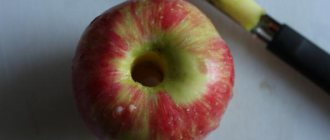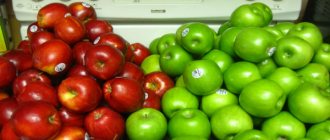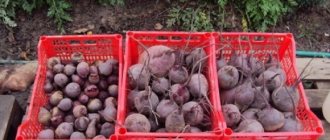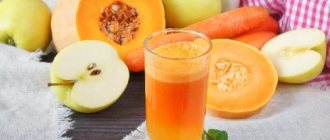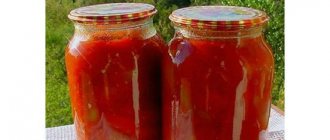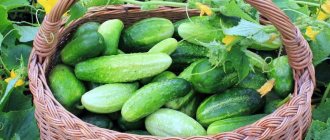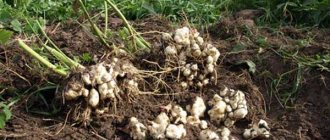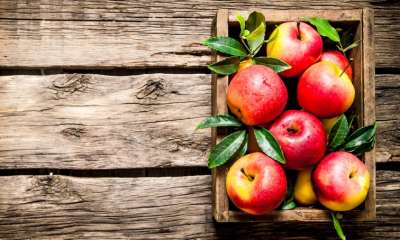
Apples are a source of vitamins and minerals that are beneficial to the body. Proper collection and storage will allow you to have fragrant fruits on the table throughout the winter.
In order not to lose the harvest, it is necessary to know all the features of the organization of the process of preserving fruits, including the choice of location, container, and preparatory measures.
Read about how to keep apples at home for the winter correctly, with what you can and cannot, how to protect the crop from mice and other rodents, read the article.
Conditions for storage at home in winter
For long-term storage of apples, only suitable conditions are needed. Temperature is especially important. It should be between 0 ° C and + 4 ° C. For autumn varieties - about 0 ° C. Such conditions are present in cellars and basements.
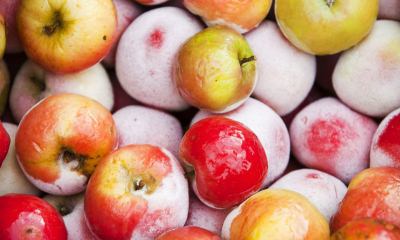

A similar temperature regime can also be obtained:
- on the balcony;
- in a refrigerator;
- in a basement or cellar;
- in a trench dug in the ground.
Violation of the temperature minimum and maximum will lead to a reduction in shelf life:
- At a lower temperature, the fruits will begin to freeze and rot.
- At temperatures above + 5 ° C, the apples will begin to dry out and wither.
In addition to temperature, additional conditions must be met for successful winter storage:
- protection from sunlight;
- humidity - 80% and higher;
- protection against flooding by groundwater;
- frost protection.
You can only lay whole fruits that do not have even minor damage. All fruit with defects should either be eaten immediately or processed.
Those that do not have a whole stalk are not suitable for storage during the winter, as they become open to fungal diseases.
During storage
do not frequently change the location of the fruit... This is due to the fact that conditions of detention will change, albeit insignificantly. As a result, the number of spoiled fruits will increase.
At what temperature you need to store apples in the winter at home, read here.
Features of apple storage
Fruits by varieties are divided into:
- Winter. Golden, Idared, Jonathan, Renet, Antonovka. Retain marketable qualities for 4-7 months. The optimal temperature regime is 0.
- Summer. Do not differ in keeping quality. They are stored in disinfected, dried boxes made of natural materials for no more than 1.5-2 months. If the temperature rises above 12, they begin to dry out quickly, wrinkle, and lose their taste.
- Autumn. Spartak, Macintosh. They will lie for 45-60 days, until April, when optimal conditions are created in basements, cellars, on the balcony.
- Immature. Stored for several months. If you select the right varieties correctly, they will last until spring, remaining crispy.
You can understand whether the apples are ripe by the first fruits that fell to the ground in September. If they fall in calm warm weather at night, then it's time to harvest.
Preparation
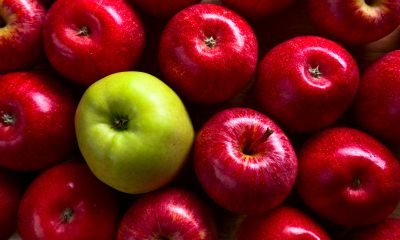

In order for the crop to be well stored all winter and even spring, you should:
- Harvest correctly.
- Sort it.
- Choose a storage location.
Before sending apples for storage, they should be sorted out, sorting according to the following criteria:
- damaged and intact;
- mature and immature;
- big and small.
Varieties
The duration of harvest storage directly depends on the apple variety. Early and autumn fruits are not suitable for winter storage. Only winter varieties need to be harvested.
Autumn varieties are also subject to storage, but not throughout the winter, but a maximum of a couple of months, provided that favorable conditions are provided, including a stable temperature of about 0 ° C.
Popular winter varieties that have a long shelf life include:
- Semerenko;
- Antonovka;
- Golden and others.
Harvest time
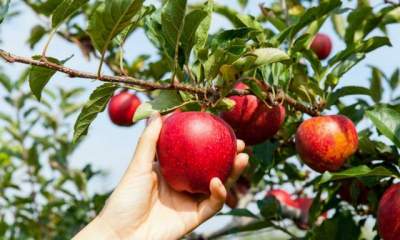

Winter varieties should only be harvested when they are fully ripe. Harvesting too late or too early affects not only the appearance of the fruit, but also its taste.
In the middle lane, the first apple harvest is harvested in mid-August. But early varieties do not have a good shelf life.
Autumn varieties begin to be harvested at the August-September border, they lie longer, but not throughout the winter. Gradually, they acquire softness and lose their taste. For long-term storage, winter varieties are intended, which it is desirable to collect from the end of September to mid-October.
You should not stand the fruit on the tree until the very frost, since frozen apples will not be stored all winter.
This article will tell you when to remove apples for storage.
Additional processing
Harvested apples should not be rubbed, so as not to remove the natural bloom on the fruit. If it is violated, the shelf life may be reduced.
Carry out additional processing:
- glycerin,
- a weak solution of potassium permanganate,
- in other ways.
You can find out how to process apples before storing them here.
Choice of containers
Most often, wooden boxes or cardboard boxes are chosen for storing apples. These methods are convenient, allowing you to compactly place the crop in the storage area. You should try to avoid contact of fruits with each other.
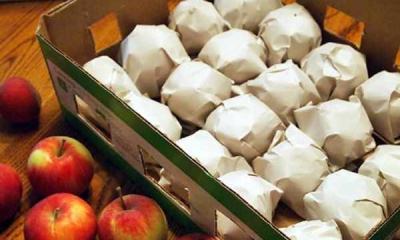

For these purposes, one of the techniques is used:
- Wrapping each apple separately in paper.
- Sprinkling with additional materials (shavings, sawdust, peat or sand).
- Gap unfolding.
Cardboard boxes, if they are chosen as containers, should first be glued at the joints with adhesive tape or reinforced in another way so that they do not break through under the weight of apples.
Long-term storage varieties
Winter varieties of apple trees with a long shelf life of fruits:
- Antonovka. The tree is characterized by high but irregular yields. The fruits have an intense characteristic aroma, as well as a juicy yellowish pulp. The fruit is characterized by a greenish-yellow color.
- Semerenko. It has firm fruits of dark green color. They have a wine-sweet slightly spicy taste. If you store the fruits of the Semerenko variety correctly, then they can be eaten until the beginning of summer. At the same time, there will be no loss of fruit taste.
- Golden. Refers to the autumn variety. Harvesting begins in September. The fruits are medium to large in size. Fruit preservation is carried out until April.
- Idared. The apple tree is characterized by regular fruiting. The fruit has a delicate aroma as well as a pale yellow pulp. Preservation of fruits can be carried out for 5-6 months.
- Also, for long-term storage of fruits, it is recommended to use such winter varieties as Charodeika, V oshod, B ogatyr, Imrus.
Video: features of storing apples in winter.
Where is better?
The use of boxes and boxes for storage is not always possible. In some cases, another organization is required.
A cool basement or cellar is the best storage space... But their absence does not exclude the possibility of preserving the harvest, since it is possible to organize it even in a city apartment.
In a refrigerator
In the refrigerator, you can store not only winter, but also early varieties of apples, which have a short shelf life.
The faster the apples are placed in the refrigerator, the better. Ideally, they should be sent for storage within the first 24 hours after harvest.
For better preservation, all fruits should be placed in cellophane bags (no more than 2 kg each). Each of these bags should be provided with several small holes for ventilation.
This article will tell you about whether and how to store apples in the refrigerator.
In the cellar
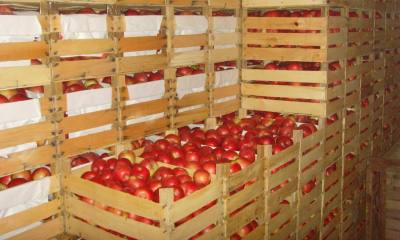

In cellars and cellars, which have a suitable humidity and temperature for keeping fruit, boxes with fruit are installed only after the rooms have been disinfected.
To prevent the contents of the container from being crushed, the boxes should not be filled to the very top., and even more so "with a slide." It is convenient to install them on top of each other.
Designed for many months of storage, fruits should be compactly stacked in boxes. Drawers can be installed not only on top of each other, but also on existing shelves. Details of storing apples in the cellar are here.
In the ground
Storing fruit crops directly in the ground is an option for those who do not have a cellar and basement on the site... A trench about 0.5 m deep is dug in the allotted area.
Its inner part can be lined with boards or lined with branches. Apples are placed on top of them in plastic tied bags of 5 kg each.
The distance between two adjacent packages laid for long-term storage should be at least 0.2 m. Top earthen trench:
- is laid by branches;
- covered with soil;
- covered with fallen leaves and branches.
In order not to lose the storage space in winter, it should be marked on top by sticking a flag.
On racks
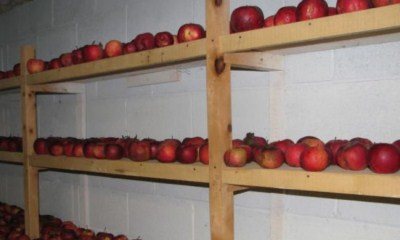

Organized racks make it possible to conveniently and freely arrange apples in one row without touching each other.
This method provides:
- Easy access.
- Convenience of inspection.
- Control over the quality of fruit during storage.
Additional convenience is provided by racks with drawers.
On the balcony
For a city dweller who does not have a cellar or basement at his disposal, a free space on the balcony can be suitable for several boxes of apples. For these purposes, not every balcony is suitable, but only a glazed one and does not have a heating system.
If the conditions on the balcony allow, even a separate thermobox can be organized. Due to the peculiarities of the organization, such a system will maintain a constant temperature and humidity, regardless of external conditions.
Read more about how to store your apple harvest on the balcony here.
Vacuum packed
Vacuum packing also allows apples to be preserved. Such packages:
- retain useful substances in the product;
- prevent the formation of moisture;
- do not allow the accumulation of gases that give off fruits.
Only dry fruits can be placed in a vacuum bag. They are carefully folded and then sent to the refrigerator. It is advisable to keep only apples in one package, without adding other types of fruits.
Various ways to keep apples for a long time
In most cases, apples are stored for the winter in a specially prepared room, where the temperature is maintained at a level from 0 to +3 degrees, and the air humidity does not rise above 90%. Apples begin to turn yellow from the high temperature. The walls in the storage room must first be whitewashed, and the floor must be treated with a solution of ferrous sulfate.
Storing apples in city apartments is possible in ordinary food cellophane bags
Chill the harvested crop immediately by placing the fruits in the refrigerator or in the basement. Sorted apples do not need to be washed and wiped, as the wax coating will protect the fruit from disease.Sometimes apples are additionally greased or dipped in melted wax to protect against pests.
The most common storage option is to wrap the prepared apples in paper and put the stalks up in a dry, clean container (moisture-resistant cardboard or wooden boxes, trellis chests, baskets). You can lay the apples on their side with the stalks in one direction, shifting each layer of the fruit with paper, wood shavings or straw. Separately wrapped apples are stored better, because if one of them rots, the rot will not spread to neighboring fruits.
Option for storing apples in plywood boxes with sand:
- newspapers are laid on the concrete floor of the basement, on top of which apples are laid out in two layers so that each fruit is in plain sight;
- after a month, the best fruits are selected and transferred to storage in a plywood box;
- a layer of sand of 20 cm is poured on the bottom of the box, apples are tightly placed on the sand in one layer, a layer of sand is again poured on top so that the fruits are completely hidden - so several layers;
- boxes are installed along the wall in two tiers with a clearance of about two centimeters.
With this storage, if the sand is not wet, the apples will not spoil until May-April, remaining juicy and aromatic.
Video about the easiest way to store apples at home
If you do not have a basement or other suitable storage room, put the collected and sorted apples in one and a half kilogram plastic bags and tie them tightly. At the site, dig a trench for one or two bayonets of a shovel, to a frost-free depth, carefully place the bags with apples in the hole, leaving a distance of 20 cm between them, so as not to damage the fruits when digging. Cover the trench with earth, cover it with branches and foliage on top to create additional warmth in winter. Remember to mark the location of each bag with a stick. If necessary, you can dig out the fruits until spring - they will taste the same as those plucked from a tree.
It is more difficult for urban residents who do not have their own land plot, but want to eat homemade apples. Storing apples in city apartments is possible in ordinary food cellophane bags. Fill the bags halfway with sorted, undamaged apples, tie and cut a hole about 10 cm long in the middle of the bag.
Place the apple bags in a warm garage or apartment to keep the fruit from freezing. On a wet day, droplets of water will form inside the bag, and on a dry day, the fruits will absorb this moisture. In such conditions, apples do not dry out for a long time, remaining fresh and firm.
In order to have fresh fruit throughout the year, it is necessary to ensure their correct storage. There are a huge number of secrets with the help of which their storage life is significantly extended. Below you will find information on how to keep apples fresh and tasty for the winter.
Methods and technologies for protection from mice and other rodents
To preserve the harvest, it is necessary not only to create suitable conditions, but also to prevent damage to the harvested apples by rodents.


There are several ways to deal with the problem:
- Using poisoned baits. The disadvantage of this method is that dead rodents can become a source of infections.
In addition, with this scenario, domestic cats can seriously suffer, up to death. - Unfolding near containers with elderberry twigs.
- Use of scarers.
Necessary conditions for preservation
To preserve the taste and benefits of fresh fruits for a long time, certain conditions are created. Particular attention is paid to the container in which the fruits will be stored, the temperature and humidity level in the room, as well as the timing of cleaning:
- The optimal temperature range for storing the harvested crop is within -3 ... + 4 degrees.With such cool air, apples do not freeze and do not deteriorate for a long time.
- As a container for storing crops, you can choose wooden or plastic boxes, wicker baskets. The main thing is that there are many holes along the entire perimeter of the container. Cannot be stored in iron containers.
First, large fruits are placed at the bottom of the selected container, at the very top there should be a row of small apples. By observing this rule, it is possible to avoid damage due to heavy pressure.
Timing
The storage time of the harvested crop depends on a number of factors, including:
- fruit grade:
- quality of apples;
- room temperature, etc.
| Variety | Maximum storage duration, months |
| Summer | ½ — 1 |
| Autumn | Up to 2 |
| Winter | 4 — 7 |
In addition to the factors listed above, the keeping quality of fruits in winter is also influenced by fertilizers applied during the season.... An overabundance, as well as a lack of feeding, can significantly reduce the shelf life, affect the appearance of the fruits and their taste.
For example, a large amount of nitrogen fertilizers leads to a rapid loss of fruit density, an overabundance of phosphorus fertilizers imparts coarseness, etc.
It should also be borne in mind that apples harvested from old trees are stored longer than from young ones. And from the outside of the crown, and not from the inside, where the fruits receive much less light.
Read about the shelf life of different varieties of apples here.
Temperature and humidity
Even after being removed from a branch in apples, vital activity continues:
- the apple "breathes", absorbing carbon dioxide and releasing oxygen;
- he needs moisture for cellular metabolism;
- fermentation and ripening of the fruit is in progress.
All these processes are optimal at temperatures from 0 to +4 ° C. However, a lot is determined by the variety. The same North Sinap or Antonov apples prefer coolness: they are stored in conditions from -1 to +3 ° C. The recommended humidity for any winter variety is 85-92%.
A slight deviation from the norm does not mean instant damage to the winter stock. It's just that the shelf life will be reduced, the structure of the pulp will deteriorate, the taste of the fruit will not fully manifest.
How to store apple juice?
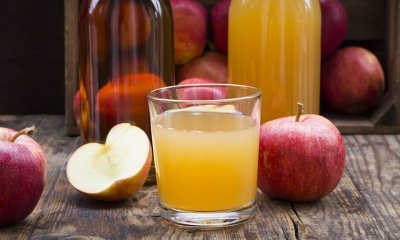

Natural apple juice, obtained by pressing fresh fruits and not processed, is not stored for a long time. It should be drunk within an hour after preparation..
Before use, it should be kept in a glass container under a lid and in a cool place.
If the juice is prepared for future use, after being squeezed and filtered, it is heated without boiling, and poured into cans, which are sealed. Store the product after cooling in a dark and cool place.
You can learn how to store apple juice, including for the winter, here.
Place to lie down
You can build a storage facility anywhere: in the ground, in an apartment, in a garage, a basement, in an attic ... The main thing is that there is a place for lying cool with an optimal temperature of 2 ° C degrees
... It is also important to have good ventilation, the humidity should be at least 80%.
In a private house, the safest place to store apples is in the cellar. But how to store apples in the cellar in winter? To do this, you must first prepare it:
- whitewash the walls and ceiling with lime with copper sulfate (1.5 kg of lime and 150 g of copper sulfate per 10 liters of water)
- sprinkle the floor with a solution of ferrous sulfate (500 g per 10 l of water)
And how to keep apples fresh in the apartment for the winter? In a city apartment, the most suitable place is a glazed balcony or loggia. But you can create the necessary conditions for lying on the windowsill, and in the pantry, and in the hallway.
IMPORTANT!
If the storage has a lot of racks, the distance between them must be taken into account: 15 cm from the floor and 20 cm to the upper container. Apples should not be placed together with vegetables, or with products that have a pronounced odor (garlic, onions).
Apples are able to retain their properties longer than other fruits. There are many ways and places to keep them fresh.The most important thing is to choose a variety, carefully remove the fruits from the tree without damaging them, and create the necessary conditions for storage. And in return, in the cold season, you will receive a whole treasure of vitamins.
How to store dried fruit properly?
Drying apples allows you to save part of the harvest in the form of dried fruits. The convenience of this method is the ability to use absolutely all varieties of apples and not throw away spoiled ones, since it is enough to simply cut off areas that are not edible.
After drying in any of the ways (from drying naturally in the open air, to processing in special dryers and the oven), dried fruits are packed with one of the following options:
- They are placed in glass jars.
- They are packed in bags made of thick paper.
After that, the dried fruits are placed in a dry place for storage. Read about the rules for storing dried apples here.
Harvesting and preparing for storage
The first important condition
for long-term storage - apples should be of winter varieties with a thick skin and a natural waxy bloom.
It is the winter varieties of apples that can be stored for up to six months. Autumn varieties under the right conditions can be stored for 1-2 months.
The second important condition
for storing apples, maintaining a constant air temperature, without drops. That is, apples cannot be transferred from a cold room to a warm one and vice versa, or the condensation that appears on the fruit will cause spoilage.
When harvesting, try to pick the apples with the stalk. When laying apples for storage, carefully select them, excluding fruits with scratches, cracks, soft areas on the fruit.
Try not to erase natural wax coating
when laying apples for storage in containers, since it is he who protects the apples from being damaged by fungus, spiers and mold.
Winter varieties of apples
it is recommended to remove from the tree slightly unripe, so that they ripen already during storage.
Removable maturity
autumn-winter apple varieties begin from September 20 to October 10, the main period for harvesting.
Attention:
Always store apples separately from other fruits and vegetables.
The ideal option for storing apples in an apartment is glazed balcony
... It is cool in winter, and the temperature for storing apples should be within
3-5 degrees
.
But if you do not have a glazed balcony, you can store apples in the hallway, pantry or on the windowsill with an open window for ventilation.
Consider the most popular ways to store apples in an apartment.
Good apples store in plastic bags
... Sorted apples are put in plastic bags of 2-4 kg each. Tie tightly and make 4-5 ventilation holes with a toothpick or match. Store at temperature
from -1 to +4 degrees
.
Storing apples in paper in bags
We wrap each apple in paper, and then put all the apples in a plastic bag. The bag will save apples from moisture loss. If it is hot, the paper will absorb excess moisture, and if the apple starts to deteriorate, it will become a barrier and prevent it from touching other fruits.
Storing apples in dry fallen leaves
... To do this, put the apples in a box and sprinkle them with dry autumn leaves so that they create a layer between the fruits. Choose leaves that are undamaged, clean, and dry.
Also a good storage method, pour apples wood ash mixed with sand
in equal proportions.
Instead of foliage, you can use buckwheat husks, onion husks, husks, peat, shavings of deciduous trees, sawdust
.
We save the seedlings
Depending on how long the seedling should be stored, the approach to solving the issue is also different.
If the purchased young plant needs to be overexposed for a couple of weeks, care should be taken that the roots with a lump of earth do not dry out.In this case, the plant itself must be kept in a cool place without removing the packaging, if present.
In cases where it is necessary to preserve the seedling for a long time, a more serious approach is required, including several stages:
- Unpacking and inspection of the roots.
- Root pruning.
- Soil is poured into the container, and the roots are buried in.
- The earth is moistened.
- A seedling with a container is removed in a dark, cool place until the time of planting in open ground.
How to save an apple tree seedling before planting in the spring, this article will tell.
Possible problems
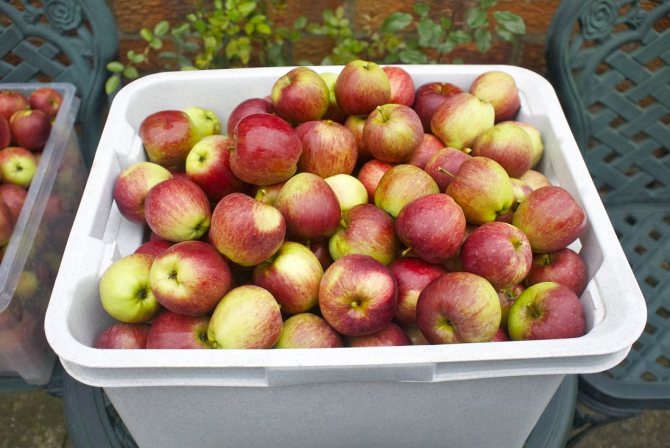

During storage, apples are checked once a month, if the harvesting deadlines and other recommendations are not followed, the fruits may turn brown or start to deteriorate ahead of time. After the expiration of the shelf life, it often turns out that when the fruit is transferred from a cool room to a warm one, the fruits turn brown. To prevent this from happening, the temperature is raised to room temperature gradually in 2-3 stages.
Attention! The temperature must be regulated (first lower and gradually increase) not in the storage area, but in the room where the apples will lie in the future.
Fruits, torn off too sooner or later, are worse stored and prone to early spoilage; they start harvesting 7-15 days before they are fully ripe. Another reason is picking on a foggy day or after rain. Storage of different varieties of fruits in one container leads to decay. The storage period is also influenced by the conditions in which the apples grew. Excessive and insufficient nutrition of trees with nitrogen and potash fertilizers, as well as prolonged hot or rainy weather during ripening, lead to unpleasant consequences.
Paste
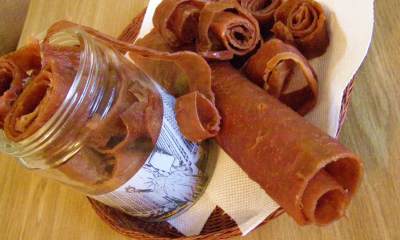

Natural marshmallow is one of the ways to harvest apples. This dessert is well kept. You can choose any of the following methods:
- in glass jars;
- in linen bags;
- in parchment and containers.
The product is stored under the following conditions:
- temperature is about + 14 ° С;
- air humidity - up to 60%.
Before being sent for storage, the pastille must be very thoroughly dried. Read about how to store apple marshmallow here.
Fresh, not Adam's apple for the winter
Before I tell you in detail and show you photos and videos about all the possible and above listed methods of storage and everyday use, I want to clarify a very important detail. The preserved fresh apples need to be chewed for a long time and carefully so that it does not become Adam's - a fact from the Bible - Adam choked, trying to swallow it whole. I myself chew the chopped slices for a long time in order to thoroughly chop the most useful ones - seeds, skin and seed chamber.
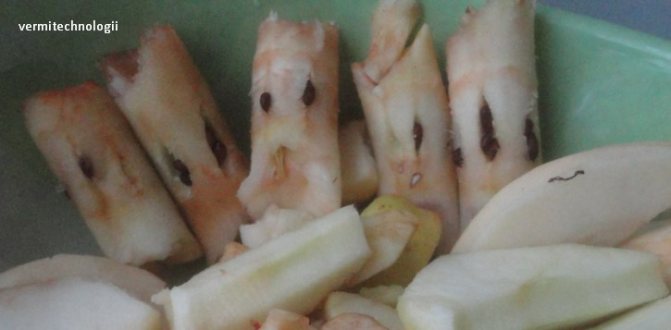

Indeed, it is in the hard parts of the apple that the maximum amount of vitamins and abrasive fiber for the gastrointestinal tract is, and the seeds are just a storehouse of vitamin B17, which prevents oncology.
Problems and ways to solve them
In the process of harvesting apples for long-term storage, various difficulties may arise, many of which are quite solvable. Gardeners may face such problems:
| Problem | Solutions | ||||
| Harvested apples have too long tails that can damage nearby fruits | They can be shortened slightly, but should not be removed entirely. | ||||
| Storage room too dry | A jar of water should be placed next to the apples. | ||||
| Some apples in storage have started to spoil | Go through the entire crop and remove spoiled fruits | ||||
| Apples placed in a plastic bag in the refrigerator become wet | Dry the fruit and transfer to a new bag, in which to make holes for ventilation | ||||
| Lack of sawdust and shavings for pouring layers of apples | Sawdust can be replaced with buckwheat husks, onions, husks | ||||
| There is a large harvest of summer and autumn apples, which are not kept fresh | Process fruits (make dried fruits, marshmallows, boil compotes, etc.) | ||||
| The natural wax coating has been erased from some of the fruits. | Carry out additional processing in one of the ways, for example, with glycerin. Or send the fruit for processing | ||||
| All apples are different - by variety, size | Conduct sorting, separating by variety, and among fruits of the same variety - by size | ||||
| Damage to fruits by diseases of fruit rot, scab and others still on the tree | They should not be used for long-term storage. If there are stains and deformed areas, the fruit should be discarded. | ||||
| Damage to mold (gray, pink) and other diseases during storage | Affected fruits should be removed from storage | Black or brown spots that grow in size | Why do apples turn black? If the fruits are not too large and collected on time, then the cause of the defect is the high temperature in the vegetable store | Vitreous | High humidity during ripening, as well as storage errors (temperature violations and poor ventilation) can lead to a violation of the formation of the fetus. |
A number of problems can be avoided if the apples are first sent to a half-month "quarantine", and after the end of two weeks they are sorted out again, rejecting those that have damage.
The ways
There are several ways to store apples.
Simple styling
Put 2-3 layers of apples in the selected container (box or basket), tails up. If part of the stem is long, you can shorten it so that it does not damage neighboring fruits.
Paper wrapping
Each fruit must be wrapped in paper, you can use newspapers or napkins. Then put the fruit in a box, stems up.


This method requires sand with an admixture, sawdust, moss, leaves, ash are suitable.
Fill the bottom of the box with loose material about 3 cm thick.
Lay out the fruits so that they do not touch, and cover with a layer of sand. So you can make 2-3 rows of apples.
In plastic bags
Fill a small bag with fruits of the same variety. Make 5 small holes in it, and store in a cool place (from -1 ° C to + 1 ° C).
In the ground
Prepare plastic bags with apples (5 kg each). Dig a hole about 50 cm deep. Cover the bottom with spruce branches, put the bags, cover them again with branches, and cover them with earth. In extreme cold, cover the pit with leaves.
In containers
Place the wooden container above the floor. Place a layer of dry straw or sawdust on the bottom. Then lay out the apples and cover with shavings. So fill the entire container.
Storage in boxes and boxes
For this method, both cardboard boxes and plastic boxes are suitable. First make a small layer of straw or sawdust, then apples. Or wrap each fruit with paper, put it in a row, and cover with cardboard. Repeat, in this way, several rows.
In thermoboxes
Put Styrofoam at the bottom of a small box, place apples on top, close the box and put the Styrofoam back on.
Now this structure needs to be placed in a larger box, and so that a distance of about 15 cm remains between them.
You can fill the void with sawdust, rags, pieces of the remaining foam. The final touch is to cover the supplies with a blanket.
UV treatment
Arrange the apples on the surface. Leave them for 30 minutes under an ultraviolet lamp at a distance of 1.5 meters. For even processing, the fruit must be turned over.
Drying
For this way suitable for summer and autumn
apple varieties. They need to be washed, dried and cored. Then cut into 5 mm slices. The drying process can take place both outdoors and in the oven or in an electric dryer. You can store dried apples in paper bags, cardboard boxes,
the main thing is that the fruits have enough air
.
Conservation
There are many recipes for canning apples. But there is one main rule
: prepared jars must be scalded with boiling water. And you can store them at room temperature.
Freezing
First you need to wash the fruits, then divide each into four parts and remove the core.Cover the baking trays with polyethylene, put slices on them and place them in the freezer. This process will last 2-3 hours at a temperature of minus 20 ° C degrees. Then place small quantities of apples in plastic bags or plastic containers. And send it to the freezer at medium temperature.
There are many ways to store the crop, everyone can choose the one that suits him best.
What can and cannot be together with?
When planning to leave apples for the winter, it is imperative to take into account that they are kept separate from other vegetables and fruits... This limitation is due to the fact that the stored apples release ethylene. This chemical stimulates the ripening of nearby fruits.
The result of such a neighborhood may be a reduction in the shelf life of the rest of the crop (carrots, potatoes, etc.) due to spoilage. In addition, the apples themselves can become saturated with an unpleasant vegetable smell, which will impair their taste.
If you can store apples in the cellar along with potatoes, you can find out here.
Common storage errors
Some gardeners make mistakes when preparing apples for winter, which leads to a reduction in their shelf life.
- Most often, fruits are packed in boxes. without stem
... Against this background, the development of fungal diseases is observed, which leads to their decay. - Do not stack fruit layer by layer
... They put apples into the box without prior stacking. This becomes the reason that half of the harvest is not saved. - A fairly common mistake is that fruits are stacked in containers. without pre-sorting
.
If you store apples correctly for the winter, you can enjoy their excellent taste and useful properties for a long time.
Preparing apples for storage for the winter is quite an important procedure. How correctly a person will carry out it affects the duration of their freshness. There are several ways to store apples, which allows this procedure to be carried out not only in a country house, but also in an apartment. During the storage period of the fruits, it is recommended to adhere to optimal conditions, which will positively affect the duration of their storage and taste.
Duration of keeping these apples in the refrigerator only 2-3 weeks
.
The autumn group consists of
:, Saffron Saratov. They are not suitable for long lying down, because
storage time - from 1.5 to 3 months
... If you put a bag of apples of these varieties in the refrigerator, it will extend their "life", but not for long. Therefore, it is better to make jam, jam, juice, wine, etc. from them.
And here winter varieties
can lie until summer. Their distinguishing feature is the ability to continue to mature in maturation. These include: Kortland, Slavyanka, Boyken, Renet champagne, Golden graima, Pepin of London, Renet baumana, Renet Landsberg, Rosemary, Sary Sinap, Kandil-Sinap, etc.
It should be borne in mind that such varieties as the Mlievskaya beauty, Boyken, need a temperature from minus 1 ° C to 0 ° C degrees. , can be stored at 1 ° С – 2 ° С. Permen winter gold, Renet champagne at 2 ° C - 4 ° C. Mantuan at minus 1 ° C to plus 4 ° C degrees.
If you decide to stock up on your apple harvest, then first you need to assemble them correctly
, because the duration of storage of the fruits will depend on this.
ATTENTION!
- You need to start harvesting in clear weather and during ripeness.
- You can not pluck the tail from the fruit.
- Do not remove the natural pollen layer from the apple.
- You need to pick the fruits with the whole palm, lifting and scrolling them with a tail.
- Start harvesting, preferably from below, gradually moving to the top of the tree.
- Fold the fruit into the prepared container very carefully.
It is advisable to place the fruits in a cool place for a couple of weeks. Then they need to be sorted out (it is better to leave those with stalks and without damage). Then divide the harvest by varieties and sizes: large, medium and small separately.
Apples continue their life processes during maturation. They breathe, emit volatile elements, and evaporate moisture. But due to the fact that their reserve substances (sugar, starch, acids) are consumed, the taste is deteriorating.
Before filling the store with crops, it is necessary to disinfect, dry and ventilate the room, maintain a humidity of about 90% and provide ventilation.
In the industrial sphere, the storage conditions for apples are practically the same. After the goods arrive at the designated place, the chilled fruits are transferred to the storage rooms.
Where the humidity is automatically maintained at 85-90%, and the air temperature is from 0 ° C to 7 ° C.
Moreover, the storage chamber should contain no more than 5% of the oxygen content
... Stationary storage facilities are above ground and buried. Ground ones are more convenient for performing operations inside the warehouse (loading, unloading goods, etc.), but they are influenced by the weather: the temperature of the outside air, wind, etc.
Therefore, it is important to have heating and wall insulation. Recessed storages are not subject to external influences, because they are constantly maintained at the same temperature. In industry, technology greatly facilitates the process of maturing fruits, but how to preserve them at home?
Secrets of experienced gardeners
Tips from experienced gardeners will help you better preserve the harvested apple harvest. The main recommendations include the following:
- The apples are harvested as carefully as possible. They cannot be wiped, poured from container into container, and even more so washed, since such actions can damage the natural wax coating on fruits.
- Sorting before storage must be carried out without fail.
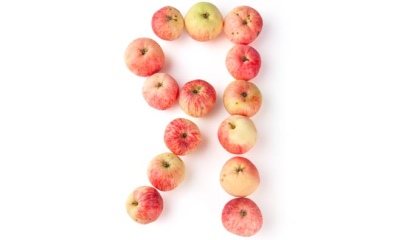

The paper that is used to wrap apples before storage must be designed specifically for contact with food and not have a specific odor that can be transmitted to the fruit.- If during storage the fruits are sprinkled with additional materials, it is necessary to check that they are always dry and cover the apples completely.
- Each unit of container for storage (box, plastic bag, etc.) must contain fruits of the same type.
- Wormy fruits are not suitable for winter storage.
- Picking apples is recommended in good dry weather.
- It is recommended to harvest from the lower branches, gradually moving to the upper ones.
- Apples should be laid with their tails up.
- Bulk storage saves space, but often results in significant crop loss. This is due to the proximity of the fruits, and their contact. Moreover, if one apple deteriorates, the neighboring ones also begin to rot.
- Improper feeding, untimely spraying, too late harvesting and other gardener mistakes can lead to damage to the fruit. Such fruits should not go into storage.
Prolongation of the shelf life of the crop can be achieved by treatment with carbon dioxide, glycerin, paraffin or ultraviolet light.
How to collect, select and prepare apples for long storage
- Many gardeners are wondering when to shoot apples for storage..
The optimal collection time is from the end of September to mid-October. - You need to collect fruits for winter storage as carefully as possible in order to eliminate the possibility of dents and damage on them, as they can lead to rotting of the fruit.
- When selecting fruits, it is necessary to ensure that there are no dents or damage on them.
Important!
If the fruits have worms, then they are not suitable for storage.
- In order to avoid the development of various fungal diseases, it is recommended to use for storage only those apples that have a whole stalk.
- During the preparation of the fruit, it is necessary to ensure that there is a natural wax coating on them, otherwise an artificial spraying of a protective layer is carried out.
Optimal conditions
To keep apples fresh for a long time, provide them with proper conditions, observing the following requirements:
- Temperature air should be ‒1… + 1 ℃. However, some varieties are well preserved at rates of + 2 ... 4 ℃.
- Air humidity – 85-95%.
- Optimal location for storage - cellar, basement, cool place in the apartment (balcony or loggia).
- Container - wooden, cardboard or plastic boxes, wicker baskets. The main requirements for containers are strength and cleanliness. It is recommended to thoroughly disinfect and dry the container before laying the fruit.
The shelf life of products is on average 5-8 months. The keeping quality of fruit depends on the variety, size, storage organization and ripening conditions. Late winter varieties of medium-sized fruits are best preserved.
Apples that have been fertilized with nitrogen fertilizers lose their density and therefore their shelf life will be much shorter. High temperature or an abundance of moisture during the ripening period of the fruit negatively affects the keeping quality of the product.
Video
Watch the video to figure out how to properly store apples in an apartment and cellar:
Young mother, wife and hostess. She prepares tasty and, most importantly, healthy dishes for household members. Therefore, he seeks and tests various options for preserving the beneficial properties of fruits and vegetables at home. The experience gained and the results of experiments is ready to share with readers.
Found a bug? Select the text with the mouse and click:
It is believed that some vegetables and fruits (cucumbers, stalk celery, all varieties of cabbage, peppers, apples) have a "negative calorie content", that is, digesting more calories than they contain. In fact, the digestive process uses only 10-20% of the calories from food.
Humus - rotted manure or bird droppings. It is prepared like this: manure is piled in a heap or pile, sandwiched with sawdust, peat and garden soil. The collar is covered with a film to stabilize the temperature and humidity (this is necessary to increase the activity of microorganisms). The fertilizer "ripens" within 2-5 years - depending on external conditions and the composition of the feedstock. The output is a loose homogeneous mass with a pleasant smell of fresh earth.
One of the most convenient methods to prepare a grown crop of vegetables, fruits and berries is freezing. Some people believe that freezing leads to a loss of the nutritional and beneficial properties of plant foods. As a result of the research, scientists have found that there is practically no decrease in nutritional value when frozen.
The novelty of American developers is the Tertill robot, which weeds in the garden. The device was invented under the guidance of John Downes (the creator of the robot vacuum cleaner) and works autonomously in all weather conditions, moving on uneven surfaces on wheels. In doing so, he cuts all plants below 3 cm with the built-in trimmer.
From varietal tomatoes you can get "your" seeds for sowing next year (if you really like the variety). And it is useless to do it with hybrid ones: the seeds will work out, but they will carry the hereditary material not of the plant from which they were taken, but of its numerous “ancestors”.
Oklahoma farmer Carl Burns has developed an unusual variety of colorful corn called Rainbow Corn. The grains on each ear are of different colors and shades: brown, pink, purple, blue, green, etc. This result was achieved through many years of selection of the most colored common varieties and their crossing.
In Australia, scientists have begun experiments to clone several grape varieties from colder regions. Climate warming, which is predicted for the next 50 years, will lead to their disappearance. Australian varieties have excellent characteristics for winemaking and are not susceptible to diseases common in Europe and America.
Convenient Android applications have been developed to help gardeners and gardeners. First of all, these are sowing (lunar, flower, etc.) calendars, thematic magazines, a selection of useful tips. With their help, you can choose a day favorable for planting each type of plant, determine the timing of their ripening and harvest on time.
Compost - rotted organic residues of various origins. How to do it? Everything is stacked in a heap, a hole or a large box: kitchen leftovers, tops of garden crops, weeds mown before flowering, thin twigs. All this is interlayered with phosphate rock, sometimes with straw, earth or peat. (Some summer residents add special composting accelerators.) Cover with foil. In the process of reheating, the pile is periodically ted up or pierced for the flow of fresh air. Usually compost “matures” for 2 years, but with modern additives it can be ready in one summer season.
Ways of packing apples for winter maturation
There are many ways to lay apples for the winter. Each gardener chooses the most convenient and suitable option. The basic rule is that every 12-14 days you need to check the harvest harvested for storage and remove damaged fruits on time.
Paper wrapping
The method in which each apple is wrapped in newspaper or paper will take more time, but the spoiled product will not affect the neighbors. When stacking in a container, make sure that the stalk is turned up. The box can be of any depth, as long as it is breathable. It is permissible to make from 6 to 8 rows.

